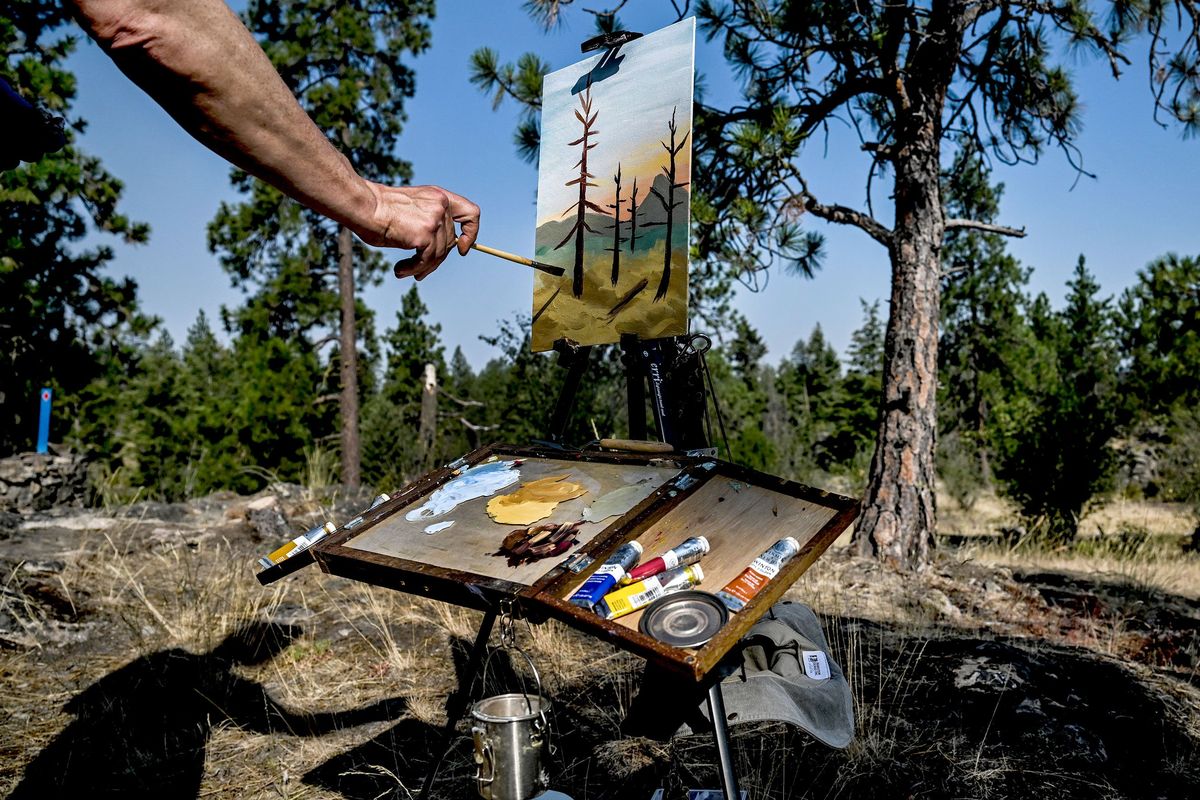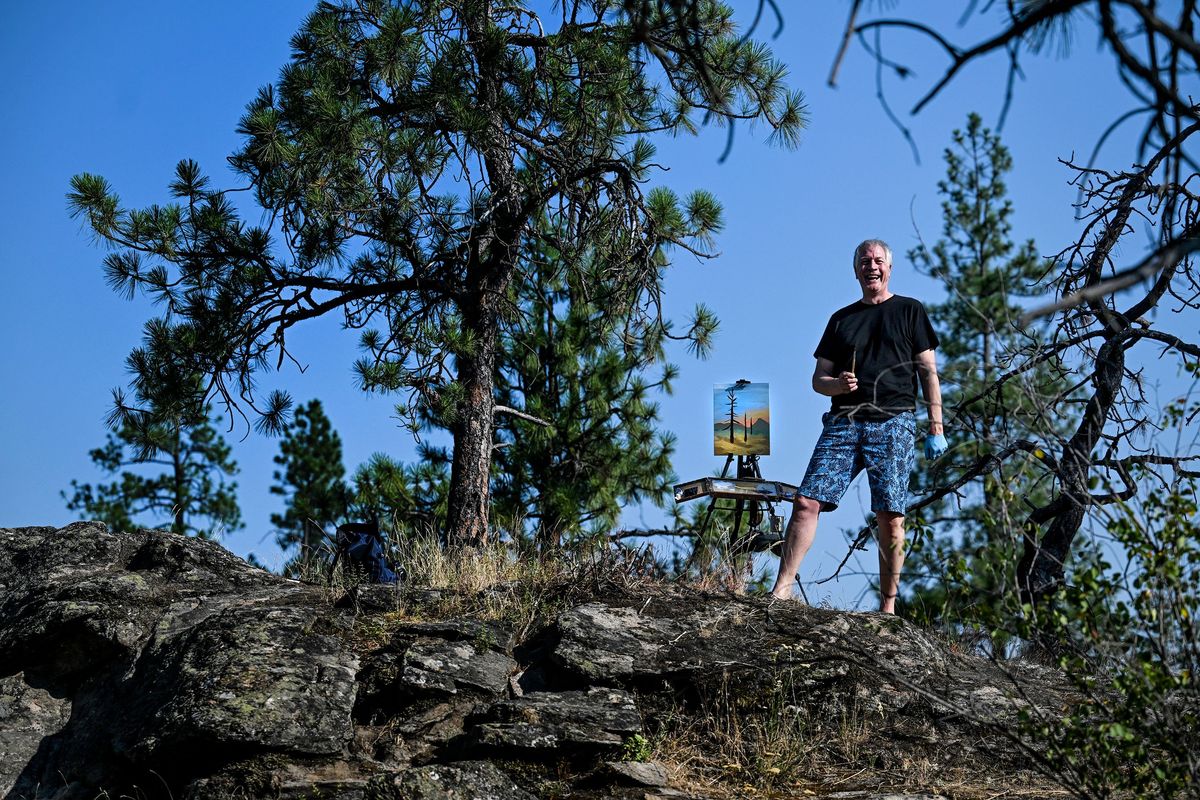‘I was horrified’: Manito Park administrators deny hobby painters’ request to paint in park gardens
Thor Anderson paints at Q’emiln Park in Post Falls on Friday. He was told that he could not paint in Manito Park by Spokane Parks and Recreation. (Kathy Plonka/The Spokesman-Review)
Thor Anderson said he was horrified when he received an email last month from Spokane Parks and Recreation that he would not be allowed to paint scenes while in any of the gardens at Manito Park.
Anderson, 60, has lived with his wife in Coeur d’Alene on and off since 2001. Recently retiring from his work as an information technology security professional, Anderson has formed a painting group with some friends. He reached out to Spokane’s parks department to confirm that his group could paint at Manito and was informed that the city does not allow painting.
Via email correspondence, a parks employee wrote to Anderson: “If we allowed this on a regular basis we would have people setting up all over and it really would cause some issues with visitors.”
“It felt like a punch to the gut to be told that what I was doing was somehow offensive to others,” Anderson said. “What are we, locusts?”
Anderson said that he had also reached out to officials in Post Falls about painting in Idaho parks. After determining that he and his friends were not affiliated with any businesses or schools, the answer was: “No problem.”
Spokane parks spokeswoman Fianna Dickson said the reasoning for artists not being allowed to set up in the Manito Park gardens is related to the sensitive environments of the gardens compared to a standard park. She said there have been requests to paint in the park before. However, they haven’t popped up enough to become an issue.
“There’s opportunities for some controlled activity in those spots, we just have to have maybe some additional parameters around those activities to ensure that they remain as open to the public as possible and, you know, receive maybe less impact from some of those activities so that they can remain those gems of our park system.”
Similarly, the Spokane Parks and Recreation Department has policies in place to regulate photography in all parks. While amateur and professional photography is allowed in most park spaces, wedding photographers and professionals shooting in the Nishinomiya Japanese Garden are required to pay a $300 permit fee. Professionals are also required to pay a $50 per use permit fee for special events in some circumstances.
Local commercial photographer and filmmaker Don Hamilton said he believes these fees are just, as photographers make money off of the beauty of the park and can in some cases take up a lot of space. He does not believe, however, that such regulations should extend to plein air painters.
“I think we oughta pay them a stipend to be there,” he said. “I’d love to see it become a problem.”
Despite email statements that hobby painting is “not allowed” from Spokane Parks and Recreation, there are no official policies stating that artists are not allowed to paint in a public park documented in the Spokane Municipal Code.
“I was very offended by their approach and being singled out. My hobby, the creation of art, which is a First Amendment protected right, is somehow not allowed in a Spokane park,” Anderson said. “I think there’s some real issues of overreach here.”
City Council President Betsy Wilkerson said preventing artists from being able to paint in public parks was “never the intent” of the park rules and regulations, including ones concerning special events and other uses of park property. She said groups of individuals are legally allowed to paint in public parks so long as there is no monetary exchange taking place.
“As a citizen, it seems out of line,” Wilkerson said of the idea of being unable to draw, sketch or paint in a public park.
Local artist Ken Spiering, the designer of the Red Wagon in Riverfront Park among other public works across the country, had an art studio in Manito Park for 17 years. Having painted in the area on numerous occasions, he said that he had never run into any conflict surrounding plein air painting in the park.
“I would seriously question administration at this point,” Spiering said when he learned of Anderson’s experience. “That, to me, is one of America’s freedoms and if they’re arbitrarily, without regulation, telling the people that have a creative bent that they don’t have a right to be in a place as gorgeous as Manito Park, then I have a few things to say that can’t be recorded.”
Director of Spokane Parks and Recreation Garrett Jones said that as soon as he was made aware of the lack of official policy, he got the Parks and Recreation team together to discuss potential solutions.
“I think we’re going to communicate with this citizen and find a solution,” Jones said of Anderson’s request. “Because there is nothing really in a policy or rule, this really gives us some opportunity to build off of this.”
Jones said that the solution will likely be the creation of a program of some sort, should they determine there is a need for it.
“This could be an art painting series as well that we could create through our recreation program and our partners at Spokane Arts,” Jones said. “It’s really finding ways to say yes and build it into a program setting that alleviates a lot of our concerns, and then still keeps these gardens accessible for all.”
Spokane Parks and Recreation’s current art programs are overseen by the Corbin Art Center, which offers painting classes and workshops for variable fees. In a follow-up email, Dickson stated that they are exploring the art center, along with the Friends of Manito and other partners as potential facilitators for the proposed programming. She stated that whether or not future programs would cost money for the public to attend is a detail the team will “need to work out collaboratively.”
Anderson said that creating a new program would be “too little too late,” and believes that Parks and Recreation should provide a written statement confirming that “the City of Spokane recognizes the creation of art as protected speech, and at this time, there is no ban on painting in any public garden.”
While not directly acknowledging that Spokane Parks and Recreation does not have legal authority to remove artists from public spaces when not causing damage or disturbance, Jones did say there would not be enforcement on their no–unauthorized–artists stance.
“It’s mainly creating that model within our event permit system,” Jones said. “Nothing about enforcement.”
Dickson said that while individuals are partaking in legal activities within the park, it is generally allowed. However when someone – like Anderson – inquires about using a specific location at a specific time, it triggers the permitting process. Anderson did not mention that he intended to reserve the space in any of his email correspondence with Parks and Recreation, and wrote that he believes his art get-together with friends should not require a permit.
After The Spokesman-Review reached out to city officials last week and five weeks after the initial rejection, Jones emailed Anderson on Monday granting him “written approval” to paint in the gardens with a small group until they are able to implement the proper programming, citing that they didn’t wish to “further hold up your planned gathering.”
Anderson said that this response left him frustrated, as it not only arrived long after his event was scheduled to occur, but also neglected to address any of the legal questions he had asked about.
“The fact that you seem unable to explain the actions of your department while aggressively working to change park reservation and permitting policies has the unfortunate appearance of an after-the-fact coverup,” Anderson wrote in an email response to Jones.
More than concern over his own ability to paint in the park, Anderson said that the issue has become one for the greater artist community in Spokane.
“I’m hoping that what they’ve been doing quietly against individuals can be stopped now, if it goes public,” Anderson said.

